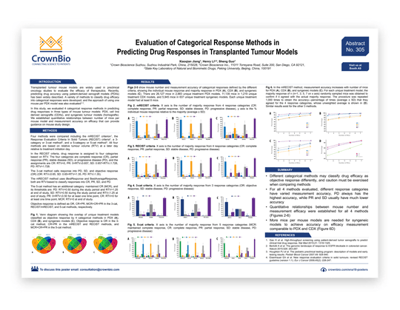Poster 305: Comparing Categorical Response Methods for Tumour Model Studies
Evaluation of categorical response methods in predicting drug responses in transplanted tumour models
Xiaoqian Jiang, Henry Li, and Sheng Guo
 Transplanted tumour mouse models are being widely used in preclinical oncology studies to assess therapeutic efficacy. Predicting drug accuracy using patient-derived xenograft models (PDXs) has been widely described, with using one mouse per PDX model also evaluated.
Transplanted tumour mouse models are being widely used in preclinical oncology studies to assess therapeutic efficacy. Predicting drug accuracy using patient-derived xenograft models (PDXs) has been widely described, with using one mouse per PDX model also evaluated.
A variety of methods have been developed to classify drug efficacy into categorical responses. However, different categorical methods may classify drug efficacy as objective response differently, meaning that caution must be exercised when comparing methods.
This poster evaluated 4 categorical response methods (mRECIST and RECIST criteria, and 3- and 5-category methods) for predicting drug responses in cell line and patient-derived xenografts as well as syngeneic models. Quantitative relationships between number of mice per mouse model and measurement accuracy on efficacy were studied to provide guidance on mouse study design.
Read this Poster to Discover:
- That for all four methods, different response categories had varied measurement accuracy, for example progressive disease always had the highest accuracy, while partial response and stable disease usually had much lower accuracy
- Quantitative relationships between mouse number and measurement efficacy were established for all four methods, with measurement accuracy increasing with number of mice per model
- More mice per mouse models are needed for syngeneic models to achieve accuracy on efficacy measurement comparable to patient and cell line derived xenografts
Download the Poster Now!

 Transplanted tumour mouse models are being widely used in preclinical oncology studies to assess therapeutic efficacy. Predicting drug accuracy using patient-derived xenograft models (PDXs) has been widely described, with using one mouse per PDX model also evaluated.
Transplanted tumour mouse models are being widely used in preclinical oncology studies to assess therapeutic efficacy. Predicting drug accuracy using patient-derived xenograft models (PDXs) has been widely described, with using one mouse per PDX model also evaluated.
